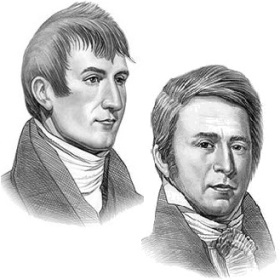|
Lewis and Clark
Native American Tribes: The Gifts
The Lewis and Clark expedition had been tasked to learn as much
as possible about the customs and culture of the Native American
Indian tribes that they encountered. In order to establish good
relations with the Native American tribes they carried a supply
of gifts to be presented to the Native Indians. The list of
gifts for the Native American tribes included beads, sewing
thread, tobacco, scissors, brass thimbles, knives, sewing needles,
brass kettles, armbands, ear trinkets, handkerchiefs, ivory
combs, silk ribbons, pipe-tomahawks, red face paint, bright
colored cloth and pocket mirrors.
Encounters with
Native American Tribes: The Teton Sioux (Lakota Sioux)
On September 25, 1804 the Lewis and Clark expedition had a confrontation
with a hostile party of Teton Sioux (Lakota) with whom they
had a difficult stand-off. The situation was diffused when the
Native Indians were given gifts.
Encounters with
Native American Tribes: The Hidatsa Tribe and Sacagawea
The Lewis and Clark encountered the friendly Mandan and Hidatsa
Native American Tribes in what is now North Dakota and built
a small fort in Mandan territory. It was here that they met
Toussaint Charbonneau and his Shoshone wife Sacagawea. The presence
of Sacagawea as a guide and interpreter was a notable addition
to the group of explorers.
Encounters with
Native American Tribes: The Shoshone Native Indians
Sacagawea was invaluable when the Corps of Discovery reached
the lands of the Shoshone Native Indians in mid-August 1805
in modern day Idaho and Montana. Her brother, Cameahwait,
had become the new chief of the Shoshone tribe and with her
plea, her brother agreed to sell some of the horses to the Lewis
and Clark expedition.
Encounters with
Native American Tribes: The Salish Native Indians
The Lewis and Clark expedition also encountered the Salish (Flathead)
Indian tribe in August 1805. The Salish were a friendly people
and provided more horses for the Corps of Discovery and gave
them some helpful advice and directions through the arduous
terrain of the Bitterroot Mountains.
Encounters with
Native American Tribes: The Nez Perce
The next encounter was with the Nez Perce Native American tribe.
Another friendly and hospitable people who provided shelter
for the exhausted explorers and provided medicines for the sick
members of the expedition. The Nez Perce also helped the Corps
of Discovery build some new canoes so the explorers could continue
their journey by water. Meriwether Lewis described the Nez Perce
Native American tribe as "the most hospitable, honest and sincere
people that we have met with in our voyage."
Encounters with
Native American Tribes: The Clatsop Native Indians
The expedition then met the friendly Clatsop Native American
tribe along the Columbia River in present-day Oregon. The Corps
of Discovery built Fort Clatsop which they named in honor of
the helpful tribe.
Encounters with
Native American Tribes: The Blackfoot Native Indians
The only violent incident that occured during the long journey
was on July 27, 1806 when the expedition fought with a party
of Blackfoot Native Indians. The members of the Corps of Discovery
were not seriously injured but two of the Native American Indians
were killed.
Encounters with
Native American Tribes: The Lakota Sioux
On August 30, 1806 the Corps of Discovery had another unsettling
confrontation with a band of 80-90 Lakota warriors led by Black
Buffalo. Captain Clark told them that the Corps would have nothing
to do with them and would kill any Lakota Sioux who attempted
to approach their camp.
Lewis and Clark
Native American Tribes: The Gifts
This article provides a small sample of the encounters the Lewis
and Clark expedition had with Native American Tribes. The vast
majority of their encounters were friendly and they achieved
the goal set by President Thomas Jefferson to learn about the
custums and culture of many Native American Tribes.
|

